Star Wars Paintings Using Cool Colors Easy Paintings Using Cool Colors
Are you looking for Tau paint scheme ideas? The Tau (or T'au) are a xenomorph race in the Games Workshop 40k Warhammer Universe. The Tau Empire is a technologically advanced xeno species that exist within close proximity to the Milky Way Galaxy on the fringes of the Imperium of Man (humans). A T'au caste called Ethereals established the Tau Empire under the "Greater Good" religious philosophy, which states that all sentient beings should strive to ensure the greatest good for the greatest number of beings in the galaxy. Tau miniatures have a diverse, but cohesive motif, from the stereotypical Japanese anime to the alien organic Kroot or Vespid models. Tau models have some of the coolest tech in the Citadel line of miniatures. The Tau aesthetic is one of the main reasons I continue to collect Tau models!
Whether you're collecting hordes of Kroot backed by a T'au fire warrior gunline, the venerated Commander Farsight, or focusing your effort on armored Battlesuits (such as the Riptide, Ghostkeel, or Stormsurge), your challenge of finding the right color scheme is both exciting and nerve-wracking. With your Tau army comes a lot of choices and responsibility for how you present the models on the tabletop.
In this article, I share some of my thoughts on Tau paint and color schemes, particularly regarding unofficial versus official Tau paint schemes. I also highlight reference images from my effort in developing a new Tau paint scheme.
To keep things simple, I organized my thoughts and images into 9 color motifs or themes. You can use my reference images as inspiration, or mix and match the colors for your Tau army:
- Red
- Orange
- Yellow
- Green
- Blue
- Purple
- Brown
- Black
- White
Continue reading below for 9 color motifs for a Tau army paint scheme.
RELATED: 5 WAYS TO CHOOSE AN ARMY COLOR PAINT SCHEME
Grimdark Tau?
Check out the Tau Grimdark themes at the end of the article.
Given the old criticism that the new Tau race (in GW terms) have a too light-hearted gunpla or anime styling that clashed with the early Grimdark Warhammer of yesteryear, many miniature painters have sought to create a darker, serious tone for their Tau models. "Grimdark" or the related "Blanchitsu" artistic terms refer to models or miniatures painted with descriptive adjectives such as battle-worn, melancholy, foreboding, dark, or heavy laden.
What are "Tau Septs"?
A Tau sept is a colony of Tau that inhabits a specific world or star system in the 40k Warhammer Universe. Although each Tau sept has a unique and independent identity with customs and traditions, Tau septs continue to thrive within a fully integrated Tau empire with a shared universal Tau culture.
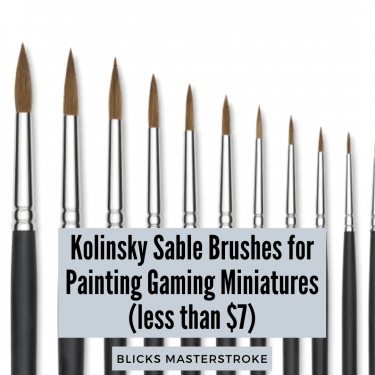
The home world of all T'au is the planet of "T'au", which is the capital of the Tau empire. There are numerous T'au septs within the Tau empire (source). Each T'au sept has its own sept symbol and color scheme. Here are a few of the official Tau sept color schemes:
- T'au – White with variations in yellow and brown
- T'aun – Dark gray with uniforms in white and black
- D'Yanoi – Light blue with brown or white with red accented uniforms
- Bork'an – Turquoise with cool color tones, such as white and grey, or blue and black; jungle themed colors include green and bone color hues
- Dal'yth – Purple with uniforms in green and gray
- Fal'shia – Tan, or dark red with light brown and red uniforms
- Vior'la – Bright red (blood hues) and bone with grey-green accenting
- Sa'cea – Orange with blue and gray
- Au'taal – Bright green with dark red and brown uniforms, accented with black
- N'oras – Black themed colors, with blue camo and dark cloth; variations of green accents
- Ke'lshan – Golden yellow with gray armor and black cloth
- Elsy'eir – Red armor and black clothing
- Tash'var – Blue with diverse variations in uniform clothing
- Vash'ya – Dark gray and any variation of accenting
- T'olku – Bright green with jade and black accents
- Ksi'm'yen – Gray or faded white armor with white clothing
- Fi'rios – Black armor with variations in accenting
- Mu'gulath Bay – Light blue armor with dark blue/black clothing
Continue reading for Tau color scheme and painting ideas!
9 Color Paint Schemes for a Tau Tabletop Miniature Army
Are you looking for easy Tau paint schemes? Here are the 9 color motifs and schemes with reference images for a T'au army collection:
(I did my best to photo credit where I found images. Sources link to original source, if available)
Red
Red is the color of danger, alertness, and romance. In color psychology, red evokes many affective emotions and represents other aspects of the human experience, including power and adventure. When it comes to a miniature 40k army, red is very popular as a main color.
Are any of these "Red Color" adjectives associated with the T'au? Sure, you'll have to answer this for yourself when deciding how you want to present your painted Tau army.
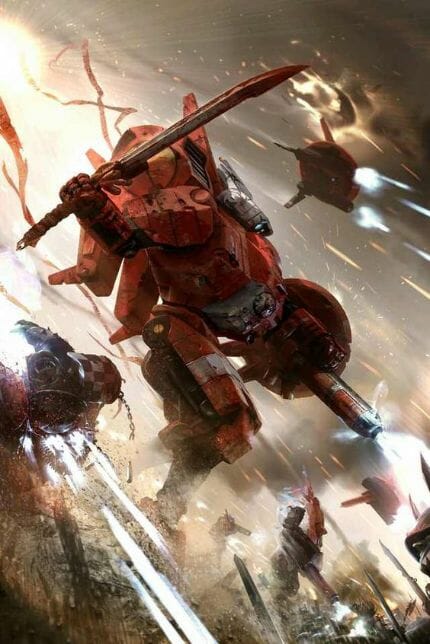
I've considered red for a few of my armies, excluding the obvious Blood Angels Space Marine Chapter I painted a few years ago.
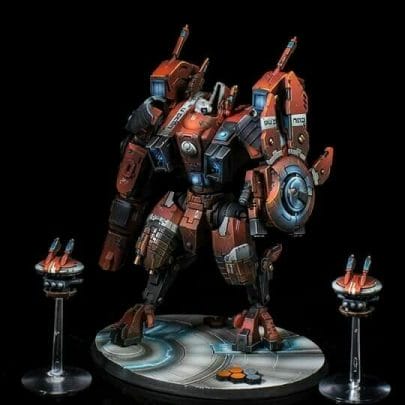
When it comes to painting a Tau army red, I've discovered a myriad of ways you can adjust hue and value to create stunning miniatures. Red is one of the easiest acrylic paints to use, since red hobby paints have excellent coverage and color saturation. You can mix and thin to your heart's content.
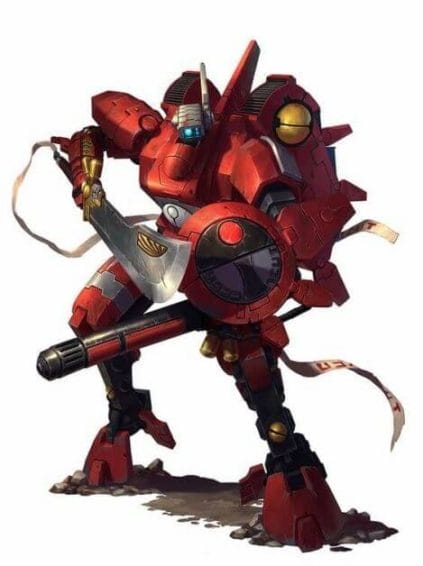
Of course, you'll want to accent your red main colour with different tones to add interest. I've always found that models painted entirely in red end up looking "flat" and boring, despite the pop from the table.
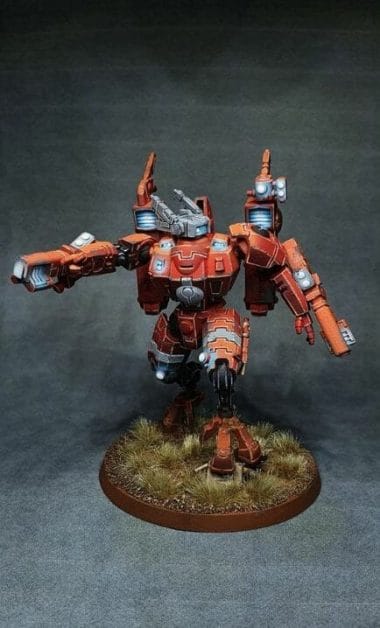
When it comes to painting T'au models, a red color scheme is a great choice for most painters because it allows for creative opportunities. You can add object source lighting, accent with neutral or cool colors. Red makes it hard to screw up. But, a well painted red Tau army looks amazing because of how much you emphasize the armor and hard edges.
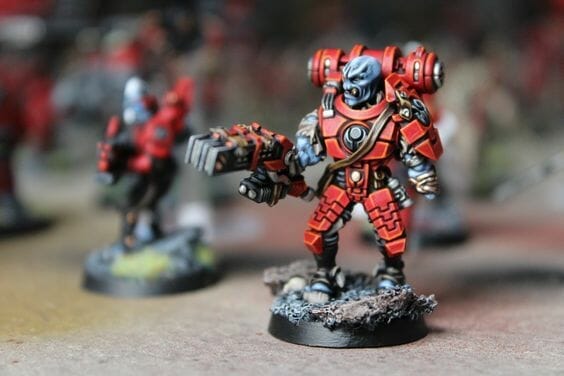
Dark lining, which is the opposite of edge highlighting, can make your model truly stand out by helping your viewer distinguish different elements on the model from other shapes and forms.
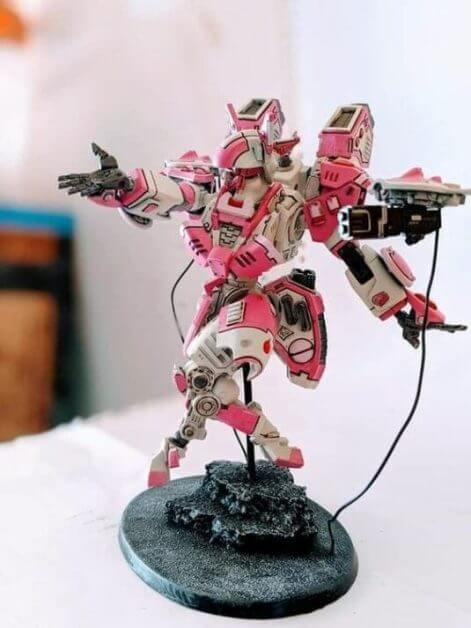
Speaking of highlighting, make sure you consider how bright and saturated you want your red to appear. If you add white to your red paint, you'll get pink as a highlight. For those of you who want less pink, and more reddish highlights, use yellow instead. Keep your saturation high for a primarily red paint job.
Although I may not use NMM (or non-metallic metal) styling in my Tau army, I've seen some fantastic paint jobs with this approach.
My favorite red paints for base coating models is P3 Sanguine base and Reaper Master Series Carnage red. Both provide great coverage, mix well, and have a smooth finish. Games Workshop Citadel Mephiston Red is another favorite, but will need some thinning for an even coat without leaving brush streaks.
READ MORE: HOW TO THIN YOUR PAINTS (10 WAYS)
Orange
The color orange is one of my favorite colors for mechanical or armored models. The brighter value of orange (and even yellow) allow you to create high contrast miniatures with a few tricks.
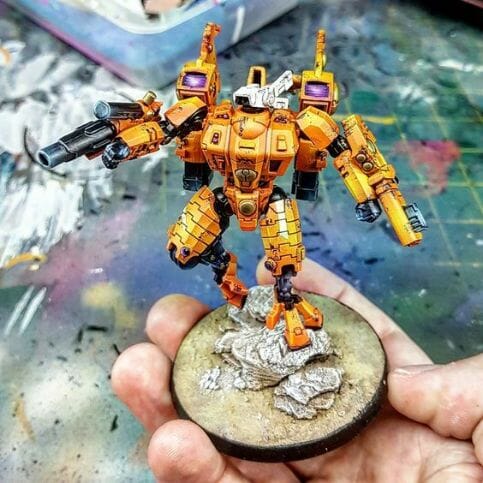
You can weather and chip brighter armor in ways that look more realistic than dark painted models. Think about real-life construction equipment, e.g., bulldozers, excavators, which sit out in the weather. Their bright paint jobs take on a "used" worn look. Painting miniature with this appearance can really add realism to your Tau models.
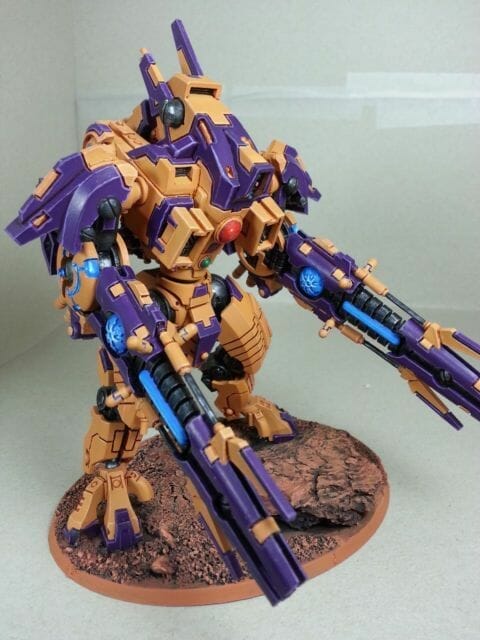
Most miniature painters may start out with bright orange, accented with other color hues, e.g., generally cool tones, such as purple or blue. But, I think as someone gets more experience with color theory and painting miniatures, they discover a ton of creative opportunities to explore different schemes with orange as the main paint color.
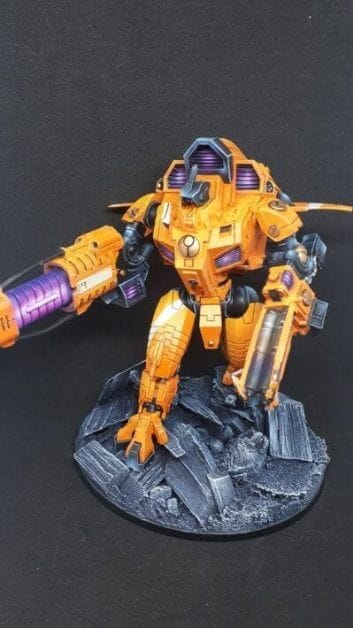
In color psychology (a fun perspective to examine how color affects human emotion and even behavior), orange is considered the color of hope and optimism. In the Tau universe, the principle of the "Greater Good" is seemingly optimistic…maybe? I suppose it depends on what side of the gun barrel you're on.
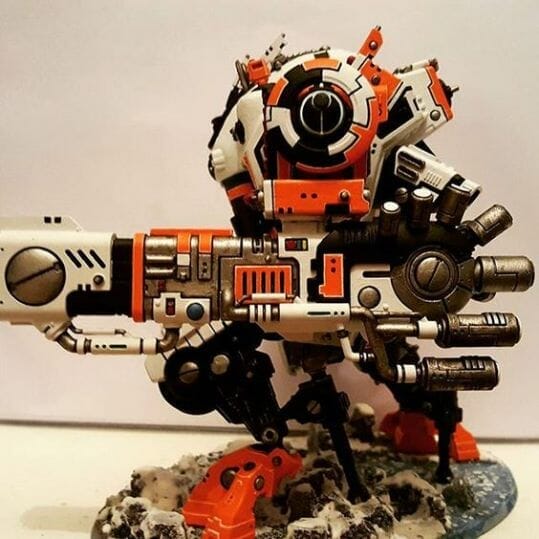
The T'au are a race of xeno (alien) beings who developed superior armaments through a serendipitous "accident" in the Warhammer Universe space-time continuum. Hidden in a time-warp, apart from the other inhabitants of the Universe, time passed long enough for the Tau to gain technological advantages that arguably exceeds anything developed by other sentient races in the Universe.
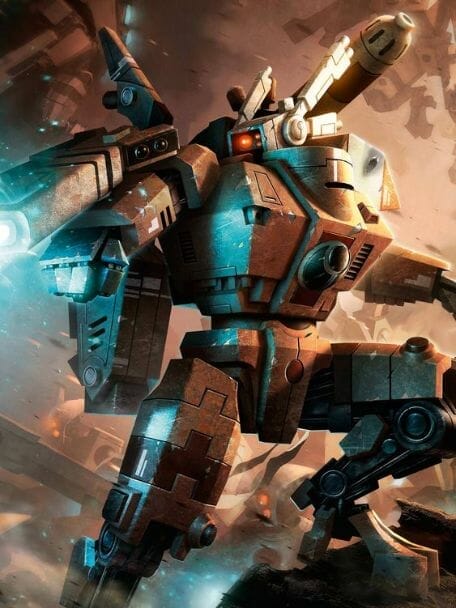
When you think about orange, remember the optimism that the T'au bring. There is hope for a lowly species to become the greatest fighting force in the Universe. All it takes it a misstep in the way temporal physics acts in the world.
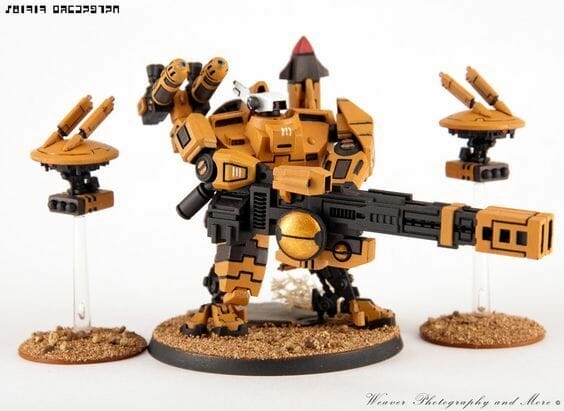
Look, at the end of the day, I love painting Tau models orange. It isn't everyday you can use different blending techniques on broad swaths of armor.
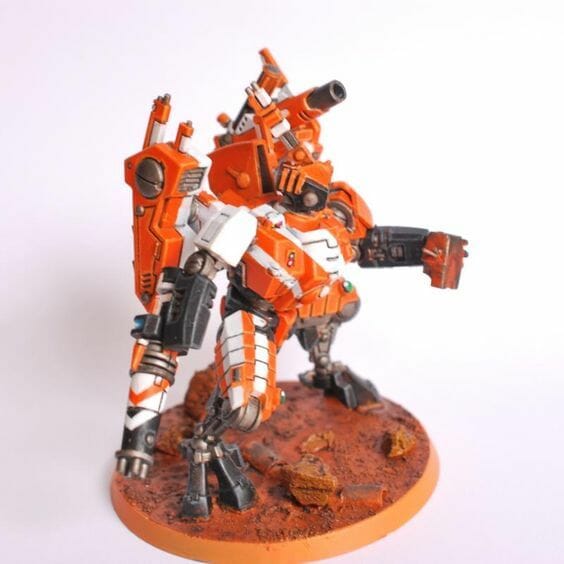
I will say, however, that orange hobby paints generally have poor coverage. That is, you'll need to layer a few coats of orange paint for a smooth finish without streaks.
My pro tip for painting orange is to start with a bright undercoat, such as white, and use an orange glaze. You can use inks or Citadel Contrast paints for this approach. You could also use an airbrush to quickly layer up your orange base colors. If you're new to airbrushing, check out my complete guide and recommended airbrush for painting miniatures.
Yellow
Yellow is hard to paint well. Painting with yellow hobby paint often produces streaks and poor coverage. If you're looking for tips on how to paint yellow, check this article.
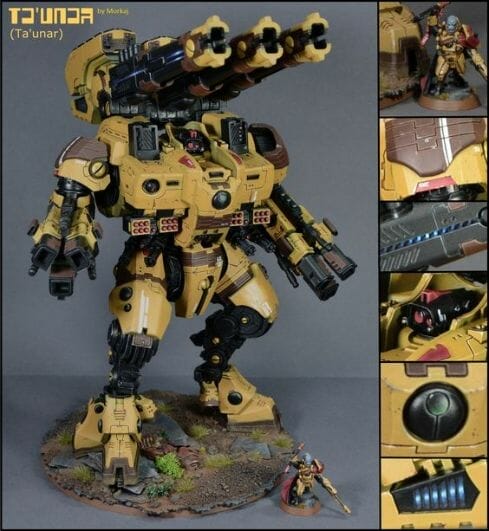
Of course, if you're looking to paint your Tau army with a mainly yellow paint scheme, don't let the challenge of this paint stop you. I have a huge Imperial Fist Space Marine collection, which is entirely yellow. If I can do it, so can you. I love the color yellow because of how rare it is on most tabletop scenes.
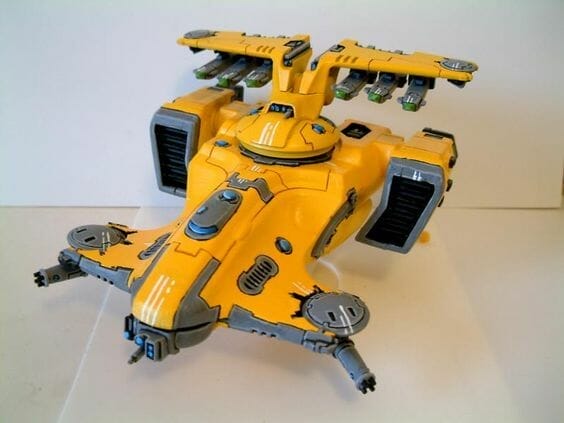
As a main color, yellow isn't a very popular color for many 40k armies, including T'au. And, as mentioned, this is for good technical reason. But, if you're looking to stand out from your peers, yellow is certainly the color to cut your teeth on for a miniature painting challenge.
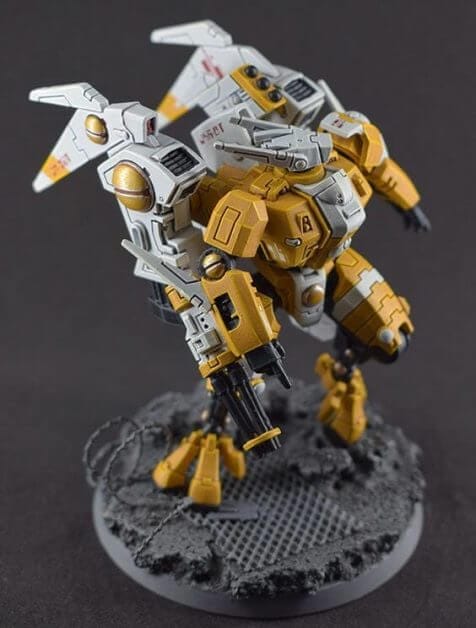
In psychology, the color yellow is associated with logic and knowledge, as well as pragmatism. Yellow gets the job done! It's a simple color hue that works for the need. What need would that be?
I have no clue. Maybe killing stuff quickly with railguns and plasma?

Yellow has many hues beyond your stereotypically bright canary yellow. You can go dark yellow, muted yellow, or even skew toward the brown tones. The color yellow allows you to weather your models with compelling and realistic special effects. There's something special about the way yellow helps you create contrast-y miniature paint jobs.
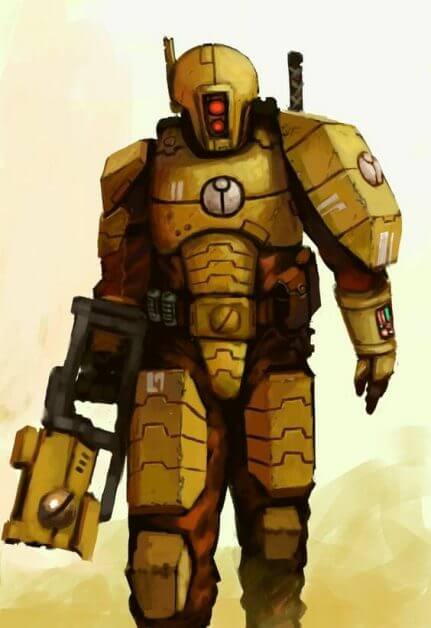
Look at some of the concept art for Tau, and you'll find a variety of ways to leverage yellow in your T'au paint scheme.
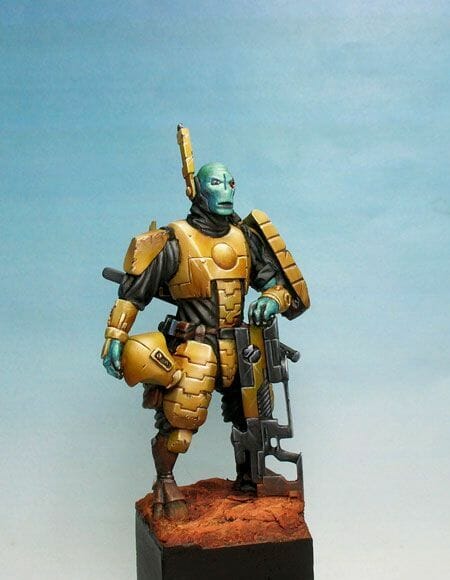
I would approach painting yellow in the same way I would with orange. Start painting yellow with a bright basecoat, such as white, and glaze with a yellow ink or wash. This starts your base tones that get you to a place where you can smooth things out and add more details.
Dry brushing is also another technique I use heavily for painting yellow. The approach allows me to start with a darker brown or neutral color and bring the yellow midtones in without streaking (e.g., where the paint shows brush strokes). For this kind of work, I use cosmetic brushes that work great as effective and inexpensive dry brushes.
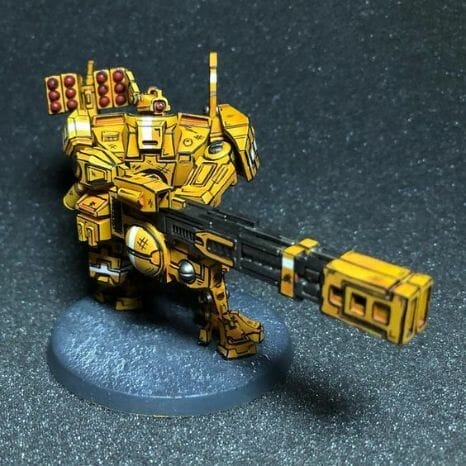
As you gain more experience painting miniatures, you'll discover ways to change up the way you approach your work. You'll develop your own style in ways that you could never have dreamed of. Trust me, it's kind of a magical outcome of painting a lot of models over the years.
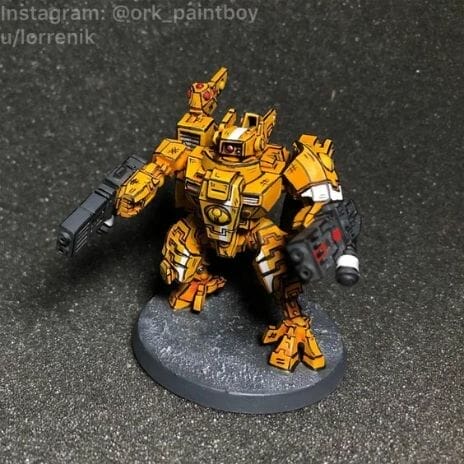
In general, yellow is great color for a T'au army. Take some inspiration from these few examples, or incorporate some of these ideas into your own work. I certainly will!
(Bonus: I think yellow is a fantastic, but underexplored base tone for a Grimdark Tau color scheme. I'd love to give it a try someday. See more about Grimdark Tau at the end of this article.)
Green
Green is a fantastic color for Tau models. If done well, you can pull of some really amazing pieces that work well as a group on the tabletop. I'm a particular fan of military style paint jobs, especially the tones you would associate with the Army. Do you recall the Euro tank camo schemes of the Cold War? Dark, muted green hues and earth tones formed the basic utilitarian look of armored vehicles.
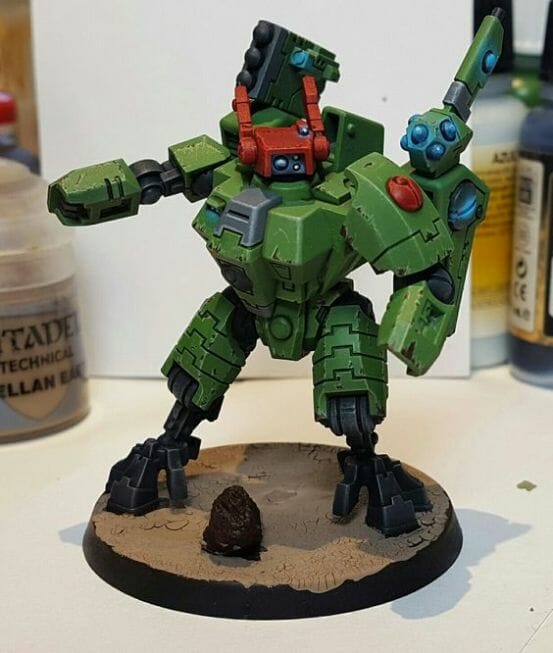
Take green to the Tau aesthetic and you could create some of the most intriguing looking models in the entire Warhammer 40k universe, in my humble opinion.
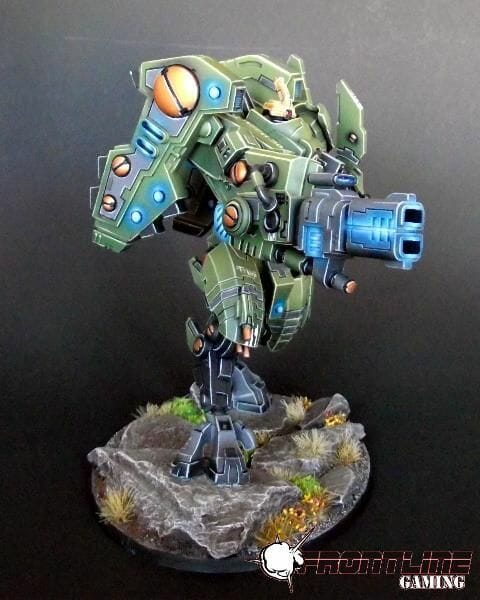
In the wrong context, however, green is an ugly color. I tend to suggest avoiding highly saturated green color schemes with equal parts red. The clashed of green and red is awful if overdone.
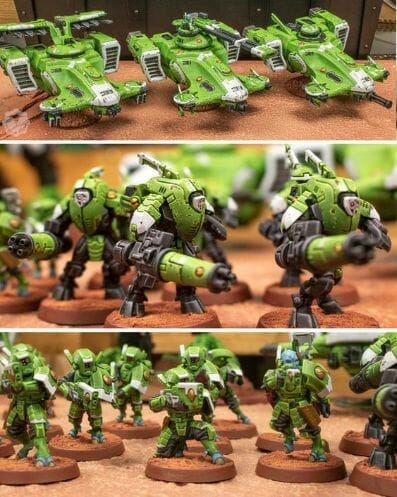
On the other hand, a splash of complementary colors over a green main color scheme could look great on solos or within a gunline. Take a look at some of these examples. A bit of blue, red, or yellow over a mainly green paint scheme adds interest and pulls up details really well.
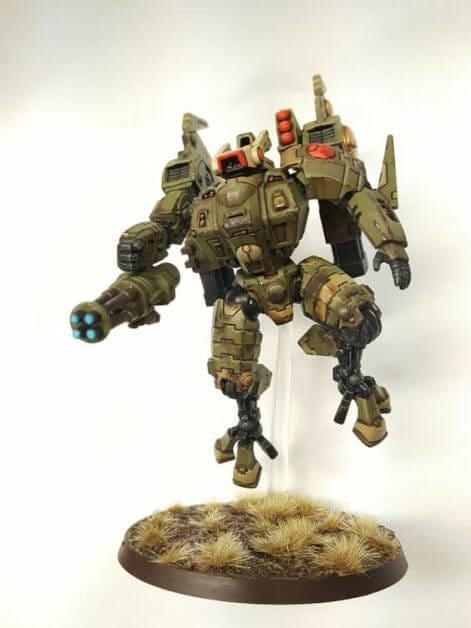
If you go with the green color scheme, consider going with a desaturated green for more realism. Or, aim for a dark brown weathering effect for a the war torn look (which I prefer myself). Use enamels, oil paints, or washes over green armor to take down the green color saturation.
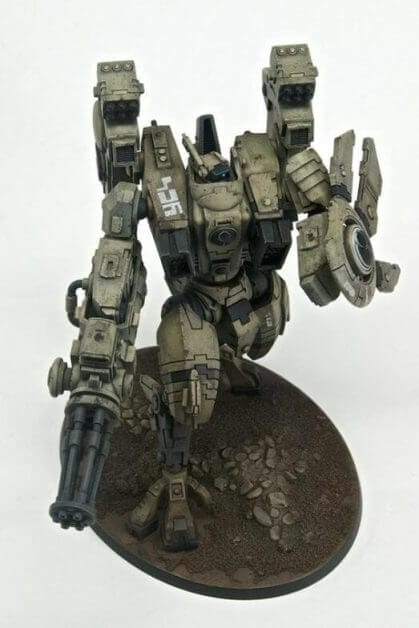
Depending on what kind of overlying washes, glazes, or weathering effects you use, you can bring a darker, grimy aesthetic to an otherwise bright green army. Modulate your color tones through airbrushing or blending effect to focus a viewer's attention on the face, the eyes (or lenses) of the model.
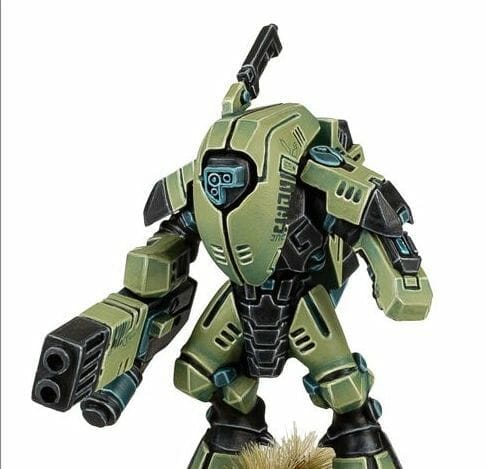
Green is a cooler tone in most miniature painting palettes. Add a touch of warmth through bone colored paints, or in the orange-red hues, for additional color contrast.
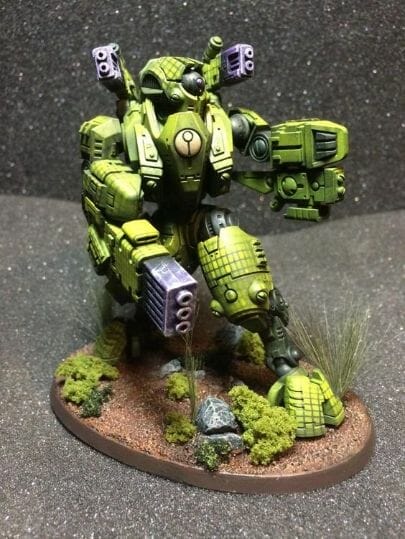
As an edge highlight, I like using yellow mixed with my main green color. For a less saturated paint scheme, I have also used beige and neutral gray as a highlight for painting green armor and weaponry on my Tau models.
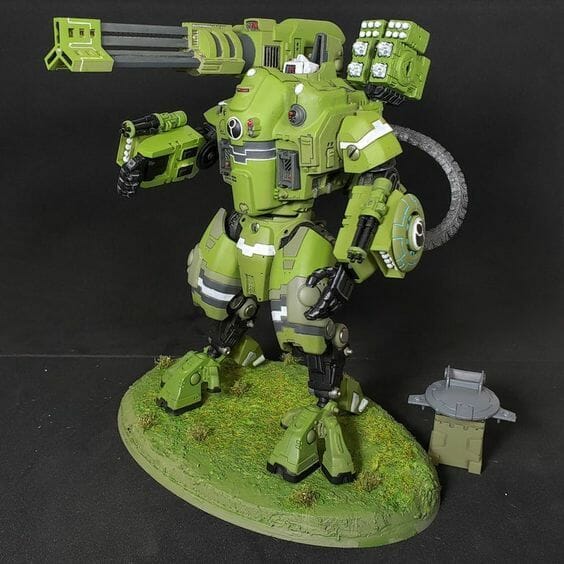
Be careful with matching your green tones and hues with any common tabletop scenery. This may look odd when you place your models on the table, if shapes and forms blend with the surroundings. Of course, if you're doing this intentionally, by all means consider a good camo scheme and add a splash of opposing color to keep things from looking too flat.
Blue
Blue is a great color for Tau, and one of my favorite color schemes for the "good guys". There's something peaceful about the color blue, even though you're painting machines of war.
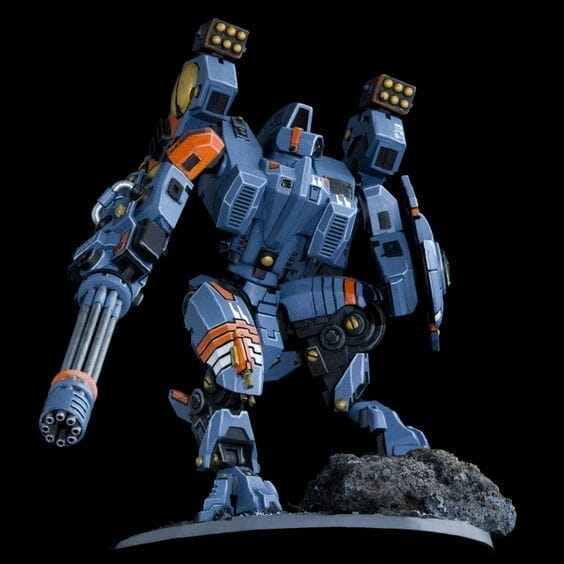
The color blue is a common visible wavelength in nature. It's the color of the Earth's sky (and who knows what color the skies are on other planets in the Universe), and the Terran ocean. Even as Sol sets over the horizon, the dark twilight casts a blue hue over the heaven sphere.
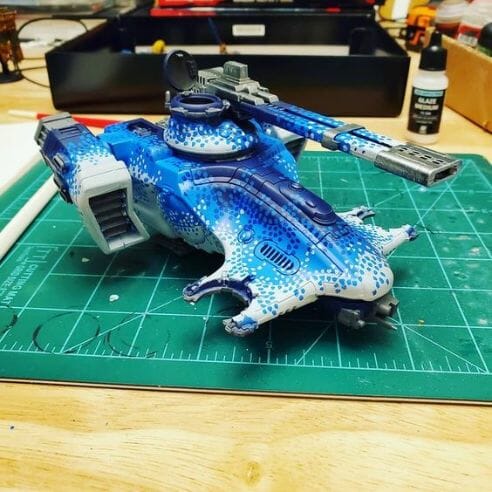
Blue is a paradoxical color, evoking a sense of peace and calm, while also exciting the senses. Painting a Tau army with a blue color scheme is a great way to add some complexity to your model through simple color harmony. Pair your blue base paint with neutral tones, or push it to the extreme by adding warm color hues, e.g., reds and oranges.
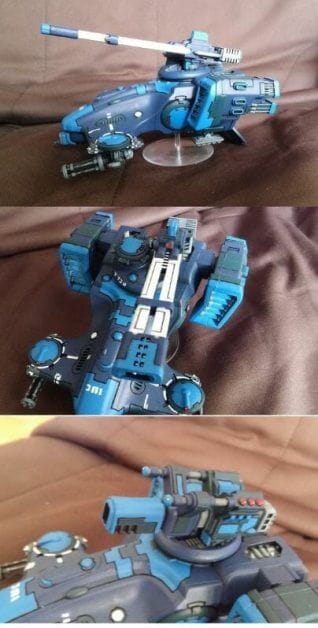
There are a ton of great concept images and references to find inspiration for a blue Tau color schemed army.

The reason blue may be so popular as a color in the Warhammer 40k Universe is that it's a great default color. When you can't decide what color to paint your models, blue always looks good as a fall back color scheme. There are many tones and variations of blue you can choose from, too. From teal and turquoise, to the light baby blues and pop styles that you often see in anime.
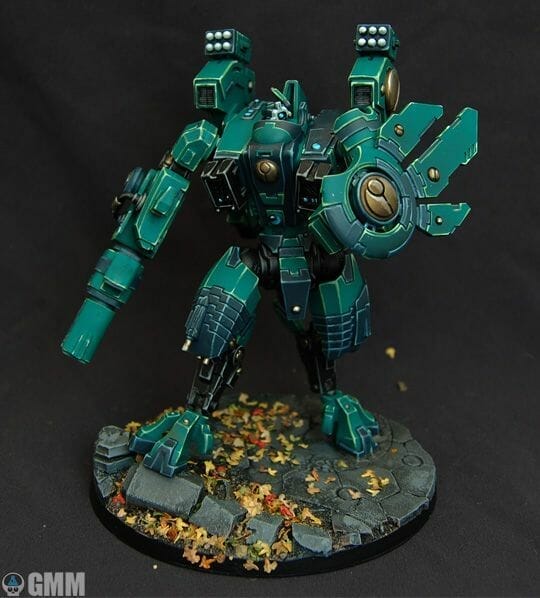
Acrylic blue paint is also an easy color to use. Most blue acrylic paints have great coverage and thin easily with a bit of water.
RELATED: 10 WAYS TO THIN YOUR MINIATURE PAINTS
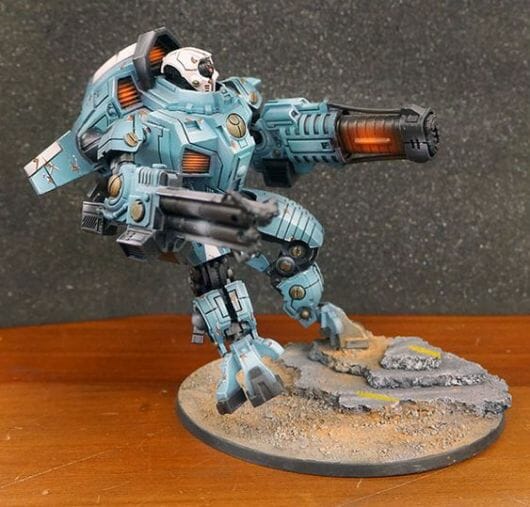
If you think about it, blue is a bottomless palette of choices. You can experiment with the variety of ways to use blue on your models. You can add glowing power weapon effects, weather your blues with warm brown-red shades, or add decals over your open areas of blue armor to create added interest.
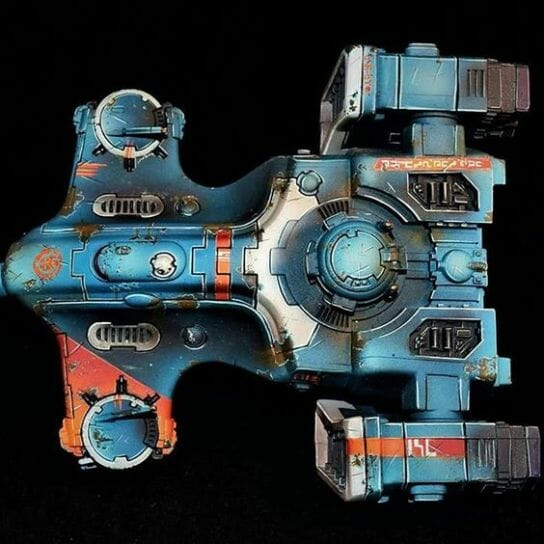
Blue works well with almost any other color. For a Tau army, this opens up possibilities beyond simple black and grays.
Purple
Purple slips between blue and red (mix the two) in the color wheel. For many, purple is a spiritual and royal color, reserved for monarchy or the court jester. In the brighter areas of the purple spectrum, violet and similar shades evoke fragility and delicacy.

For a Tau army, it's your pick. Tau grunts are notoriously fragile in certain situations, e.g., melee combat. In this case, purple may naturally fit this stand back and fight gunline style of gameplay.
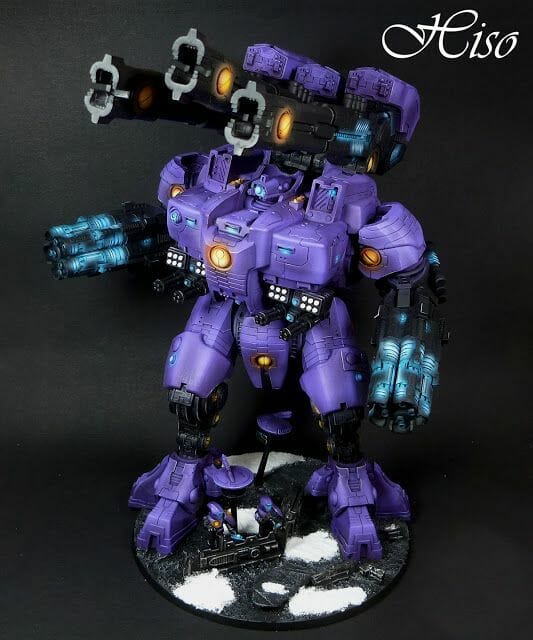
But, let's just admit something. Purple is a great color because it's unique for Tau armies. It's fairly difficult to find great images of Tau models painted mainly with purple.
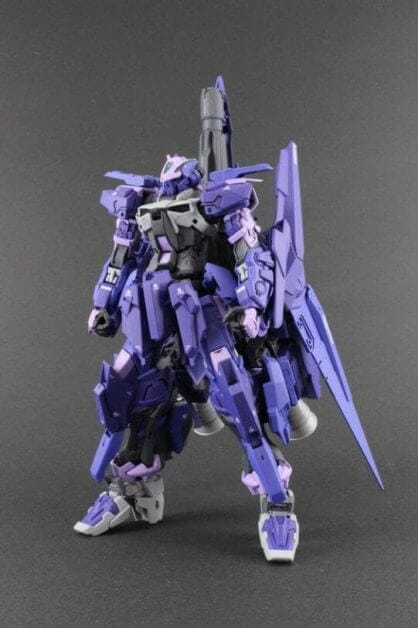
In fact, I had to explore other model genres, e.g., gunpla, Gundam, for inspiring purple color schemes that I could borrow for a Tau paint job.
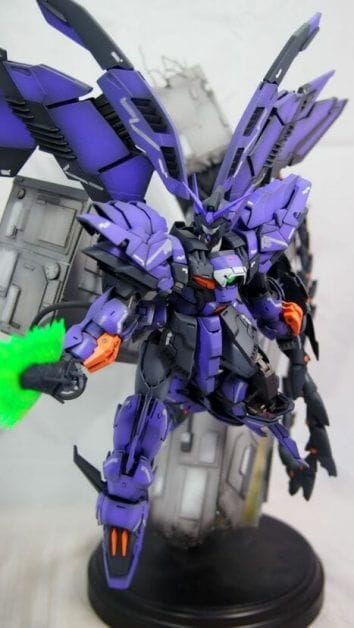
Perhaps purple isn't very popular because it can be difficult to match properly with certain Tau aesthetics. Dark purple might as well be black or gray (see more below). Bright purple may appear too pink for many.
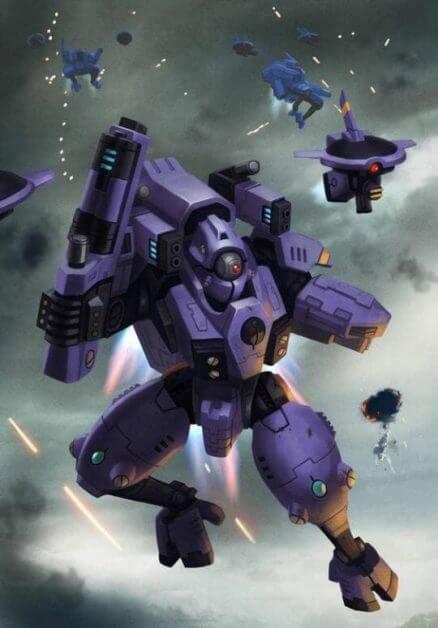
The use of purple as the main surface color may also come off as hard to read on a tabletop, concealing armored shapes and forms within joints and metallic parts. For my approach with purple, I've often used purple as a major secondary color along with neutral tones, e.g., bone or neutral grays.
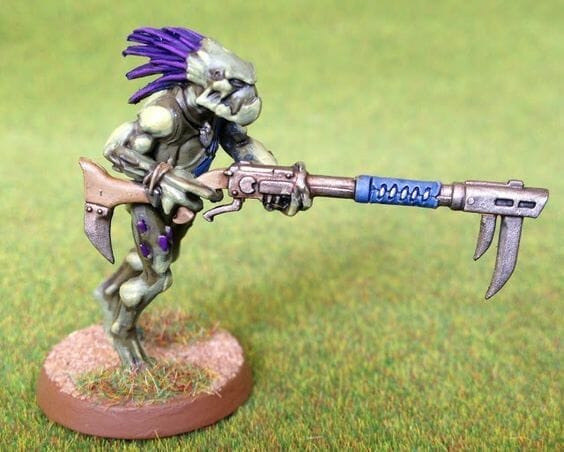
A splash of orange in an army of purple Tau also brings attention to key details, such as ordnance and glowing plasma emissions. Even though purple may be difficult to paint in large swaths over a T'au army, you'll find purple to be a rewarding color scheme. I hope to get a painting commission that incorporates purple as the main Tau color scheme.
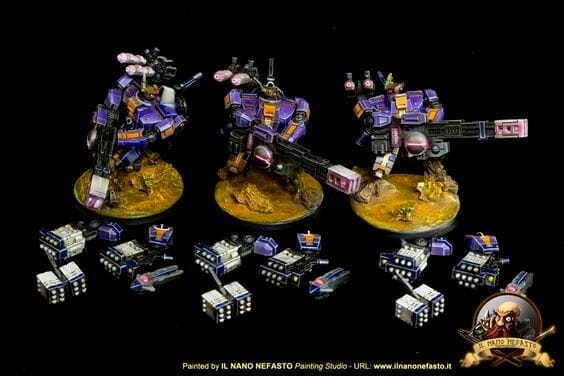
Brown
Brown is an interesting color for Tau. At first, it's hard to envision brown schemed, mecha style models. But, upon closer inspection of other peoples' Tau models (see images), I think you'll find a lot of opportunities with a brown color scheme for a Tau army.
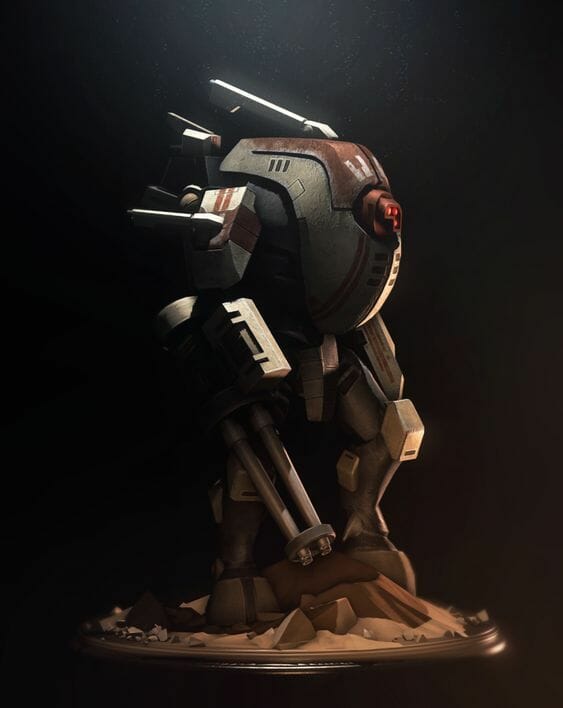
Brown is an earthy color, remicicent of dirt or sand. In different disciplines, e.g., psychology and art interpretation, brown is a a grounded, earthy color that you would use to represent stability and peace. For the Greater Good, indeed….
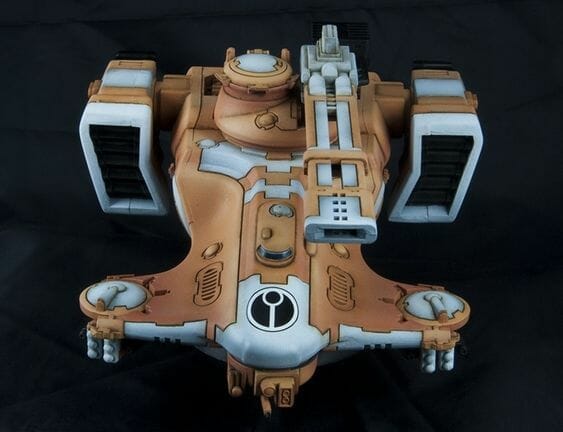
Aside from blue, of the references I've discovered, brown is the color scheme that best catches my eye for Tau models in the 40k Universe. There's something compelling about a well blended brown, beige, or sandy colored Tau model. You can work a lot of different special effects into a brown painted surface.
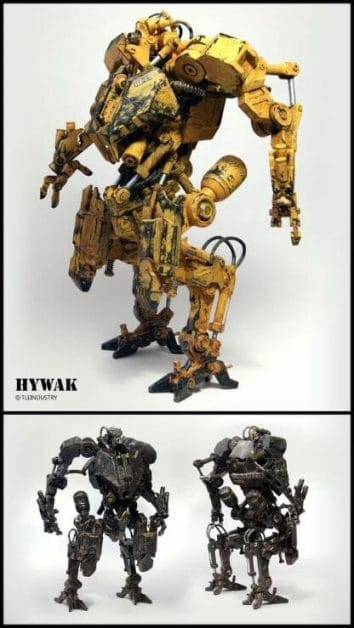
For mechanical parts, brown seems like a natural undertone for weathering and showing off wear and tear effects, e.g., chipping, grime, and grease. A good start would be to make your basecoat a lighter brown tone, and use darker reddish browns for overlying effects.
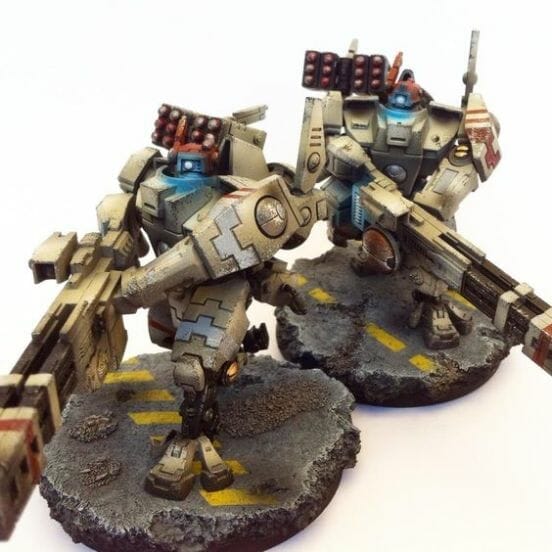
Brown and its related shades and hues, e.g., bone, warm whites, are fairly easy to paint with a regular brush. Hobby acrylic paints in the brown range have good coverage and color density. They make great washes and glazes, if you're looking to use more advanced blending and painting techniques.
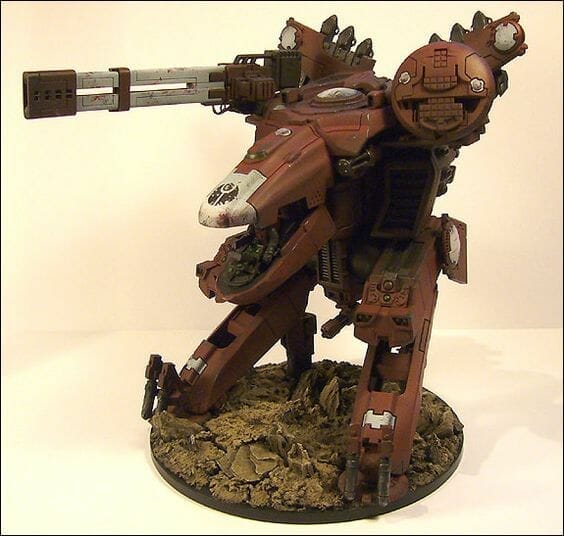
You can even skew your brown main colors toward dark red hues to add a bit of interest to your Tau models. Use yellow or other white decals to add points of interest to really make your miniatures pop from the tabletop.
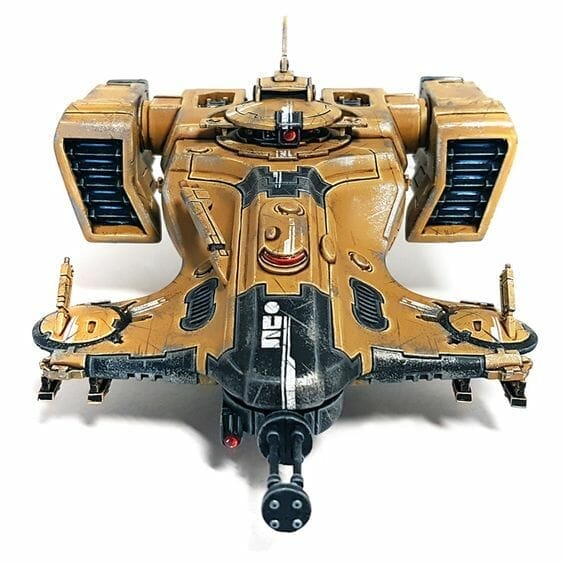
Some of the box art for Tau miniature kits use yellow ochre as a main base paint. Personally, I think this is a great color that embodies the brown schema for the Tau aesthetic.
Black
Okay, let's get this out of the way. Black is cool. It's stealthy and slick. But, black is hard to paint!
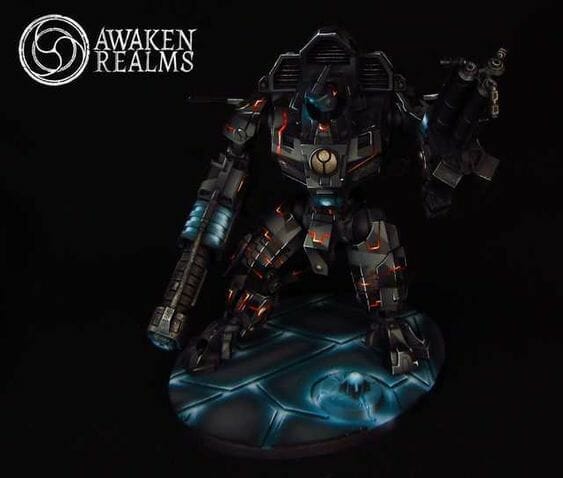
Black is about power, control, and authority. You don't mess with black, because it'll sneak up on you in a dark alley and cut your throat…or dance with you while you sleep.
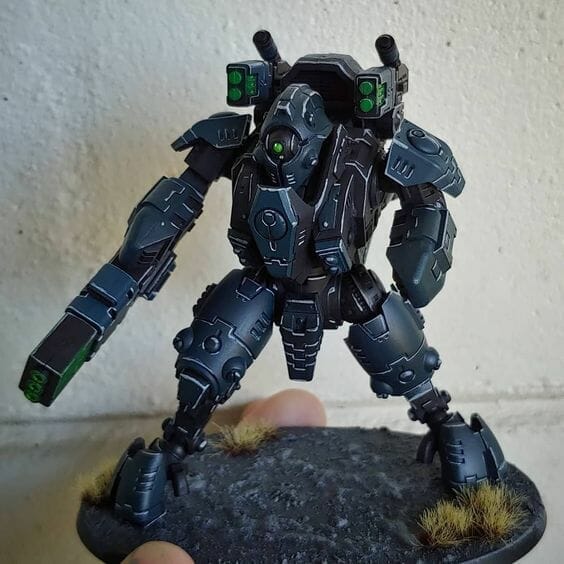
Black is hard to paint on models because it is hard to shade (create shadow) and highlight. The best tip I have for those looking to paint their Tau models with a black paint scheme is to add a bit of color into your black base coat.
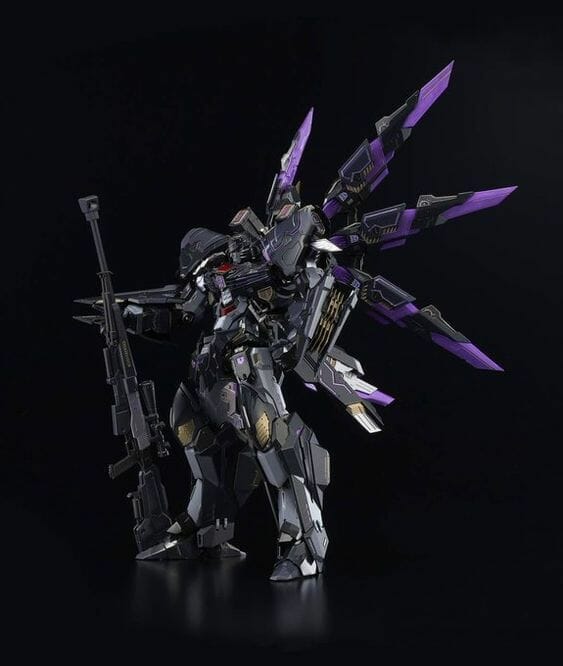
The key to painting black miniatures well is to follow the "more than 50% rule". If you keep more than 50% of the visible surface of a model black, then you are free to use any color as an accent or highlight. The more surface area that remains black, the more black-looking your model will appear.
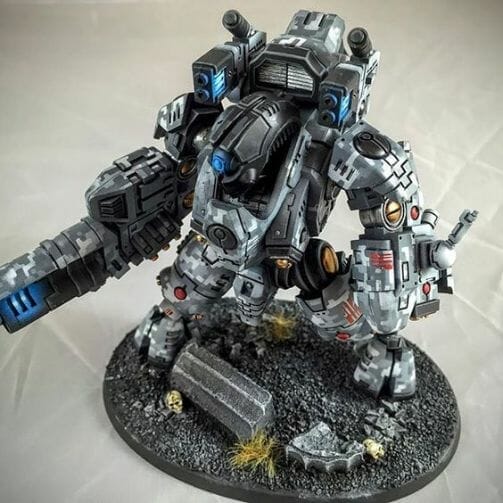
For Tau models, consider starting with a Citadel Contrast color such as Black Templar, painted over a white or light gray undercoat. This will help you find the natural shadows and highlight areas, as well as help you darken the panel lines.
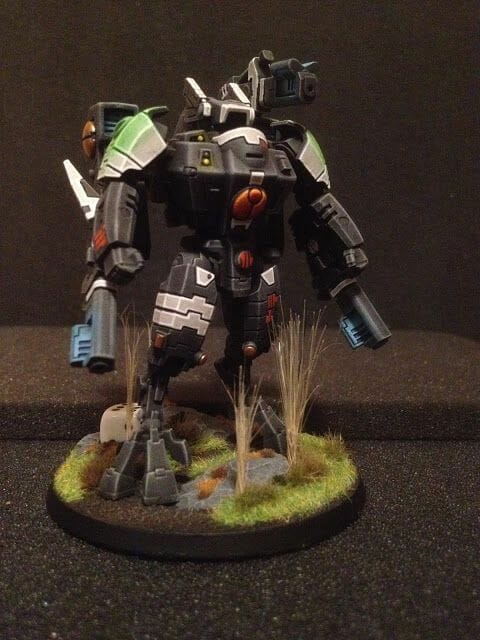
A neat trick I've learned for highlighting black is to use a dry brush application of a light gray color. Using a dry brush, you are able to lightly coat the raise surface with a brighter value, which adds contrast to an otherwise flat black surface. You can glaze over this dry brushed area to add a bit of color, too! Give it a try for a unique effect that still keeps the black main undertone.
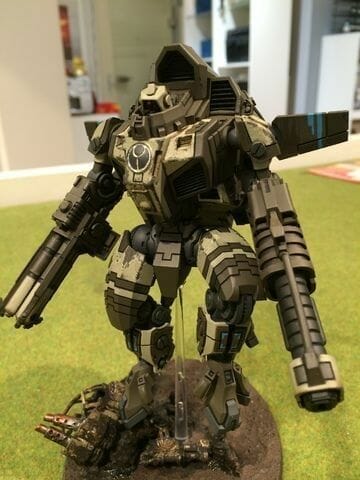
For some inspiration, the reference images above should give you a sense of what you can do with a black paint scheme for your Tau army. Remember, to varnish your models with a matte sealant when you're done painting. Removing reflections from your completed model will help you achieve a more professional appearance for your Tau models. And, matte black is a favorite.
White
Pure white is an extreme color value for painting miniatures, which makes it difficult for most miniature painters to pull off well. White acrylic paints are often clumpy, don't provide good coverage, and tend to require many coats to form an even, smooth surface. But, if done well, you can achieve some pretty neat effects, particularly for Tau minis.
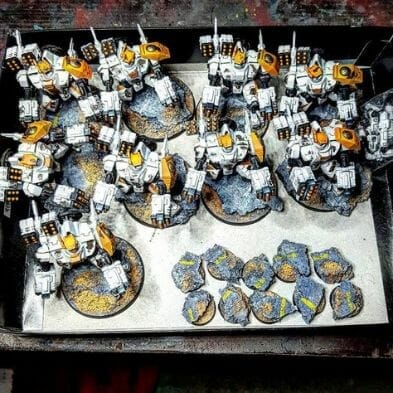
In some cultures, white is the color of purity. Whereas in other traditions, white is death. Take your pick.
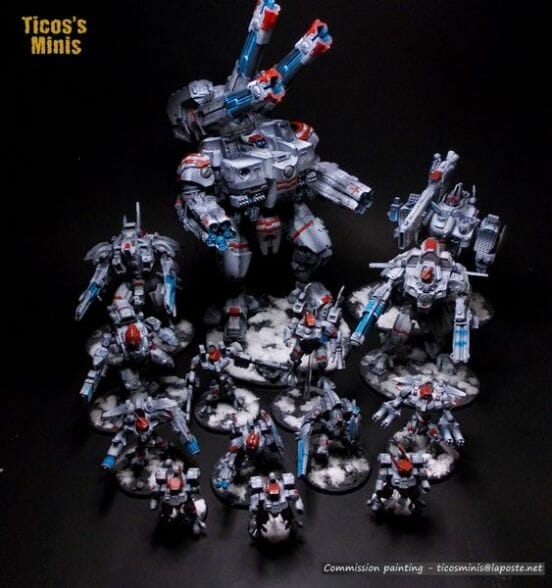
White is a paradoxical color. It represents both the absence and presence of all color. In this regard, white is whatever you want it to be… take for example a blank piece of paper, or an open book with no words.
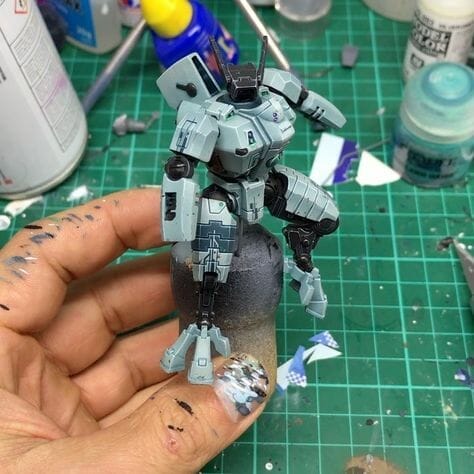
Your unpainted Tau models are a veritable blank canvas ready for whatever you want them to become when you consider a white color scheme. Of course, this is another reason white is often difficult for painters to use as a main paint scheme. You're not sure what to do with all that whiteness.
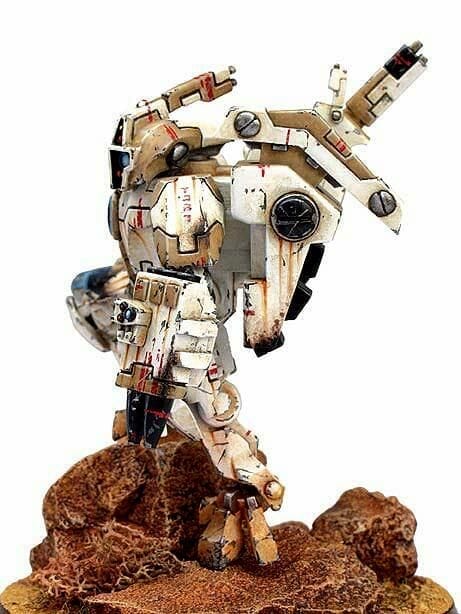
If you add too much color to a primarily white schemed Tau army, then doesn't that model become that color? How you properly paint white as a main color scheme?
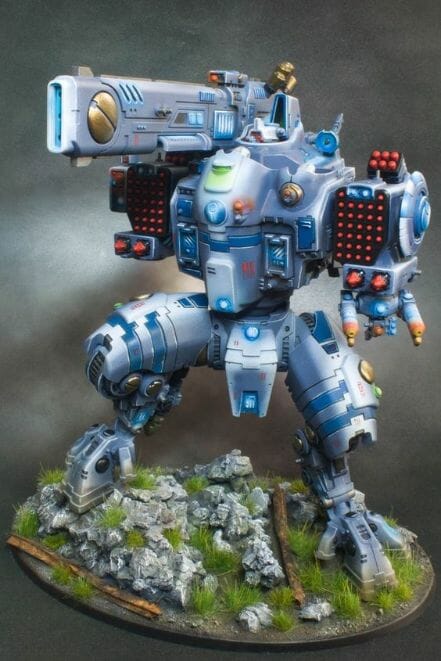
My tip for painting with white paint include using a spray application either with an airbrush or aerosol spray can, or using a bit of non-white paint mixed into your white color to tint your main white undertone. A tint of brown, blue, or whatever you prefer can add "tooth" to your white paint. It will also allow you to highlight with pure white.
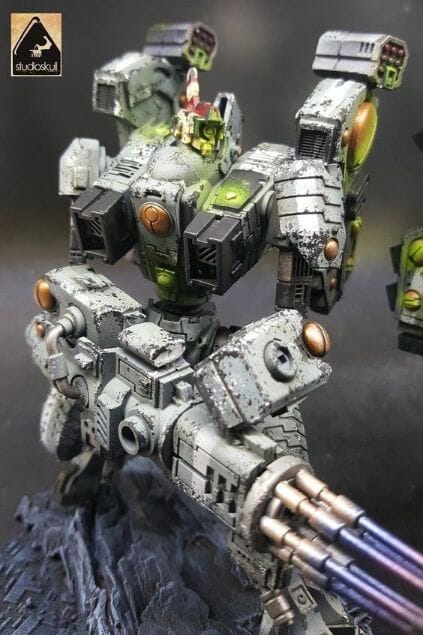
As you can see in some of these references, a white paint scheme doesn't necessarily mean the entire model needs to be painted in pure white color. In fact, for a good paint job using white as the main scheme, follow the same rule for painting black. Use the more than 50% rule. Make sure the surfaces you want to appear white are more than 50% painted white.
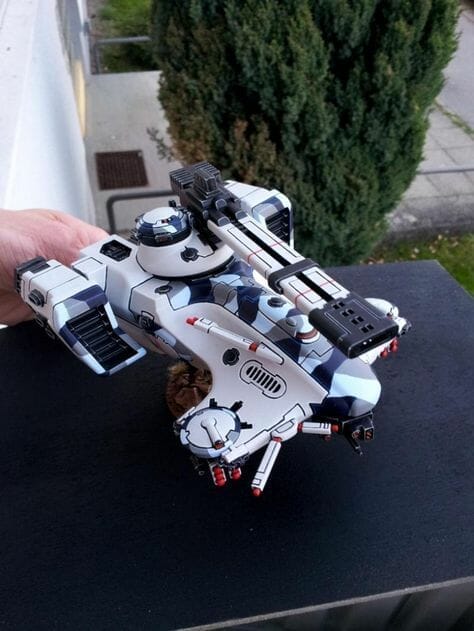
You don't necessarily need to add color to a white themed Tau army, but it helps. Use references to help guide you with color choices to accent your white paint scheme. I don't trust my eyes sometimes when it come to painting with pure white or black. Even the subtle color cast from a desk lamp can influence the final look of your finished painted miniature.
RELATED: 13 AMAZING HOBBY LAMPS FOR PAINTING MINIATURES AND MODELS (REVIEW AND GUIDE)
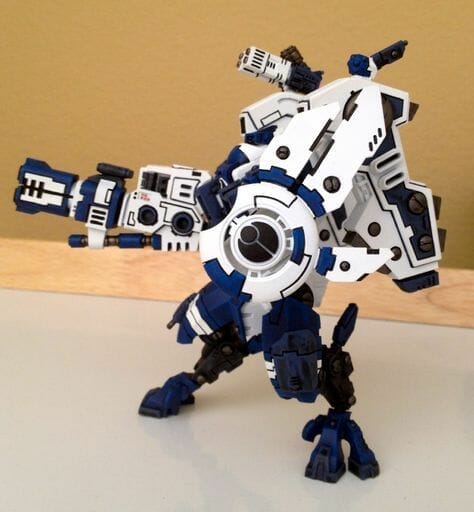
Finally, remember to give yourself room to add contrast to your white paint job for the best results. Your midtone should not be pure, bright white. Instead, reserve your pure bright whites for the highlights. For the mid tone of white, add a bit of color to shade (e.g., darken) the value a bit. Once you get the hang of painting with white paint on your models, you'll want to try using it a lot more across all sorts of miniatures!
Grimdark Tau Miniature Painting
What is "grimdark" in miniature painting?
The definition of "grimdark" over the years has been a moving target. Grimdark takes on a different meaning depending on who you ask or what online reference you rely on for your Warhammer 40k lore.
In general, the grimdark motif as a paint job may fall into two categories:
- An artistic atmosphere that depicts an ultraviolent, brutal world of never-ending war (source)
- A broader concept based on the worldview that all sentient beings are amoral (lack any sense of good or evil), and pursue only survival of the species (source) through foreign domination, subjugation, and self-proliferation (source)
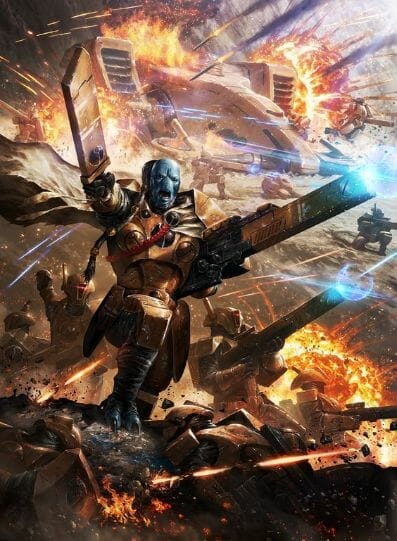
When you're painting Warhammer 40k models with an eye for a grimdark motif, you're aiming to achieve a look that conceptually represents #1 (brutal atmosphere) or #2 (amorality).
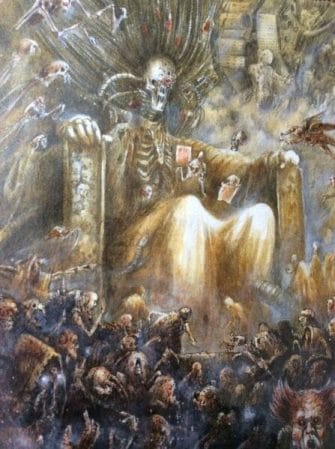
This doesn't means you're taking adjectives like optimism, peace, and tranquility, and flushing them down the toilet. No, in fact, I think the best representations of Grimdark miniature paintings incorporate bright, elevated elements in stark contrast to the grimdark atmosphere.
As such…
Tau are perfect for depicting a grimdark Warhammer universe
When people first see Tau models, they see an optimistic, utopian future where the "Greater Good" has prevailed and truly exists. Who wouldn't love to live in a technologically advanced society where all your neighbors wanted the best for you?
For a quick way to see colors on Tau models and test your color scheme ideas, check out this convenient Tau Paint Scheme Generator.
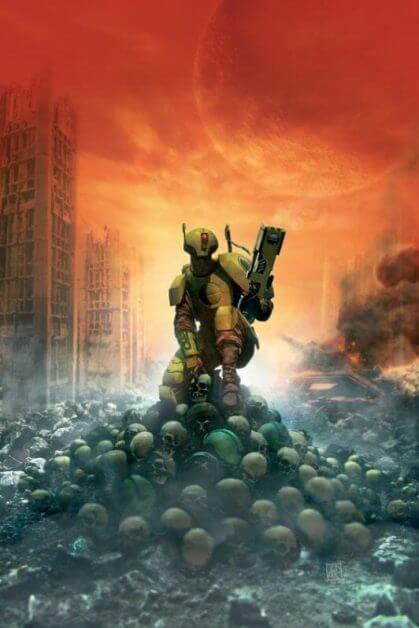
But, let's take that utopia of the Tau vision and toss it into the rest of the Warhammer lore. Tack in the the horrors of the Warp, the incursion of demonic forces through the Eye of Terror, and the mass murder of naivety. This is the grim reality that the Tau have emerged into as the new race on the 40k block.
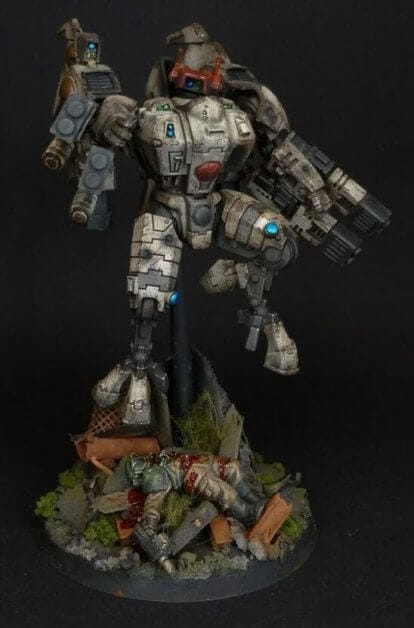
The innocence of the Tau has been shattered, and all their technological know-how is brought to bear on surviving. Just surviving. Sure, the Greater Good is their guiding principle, but to spread their evangelion the Tau must fight to survive and dominate. Rip n' tear, impale and implode.
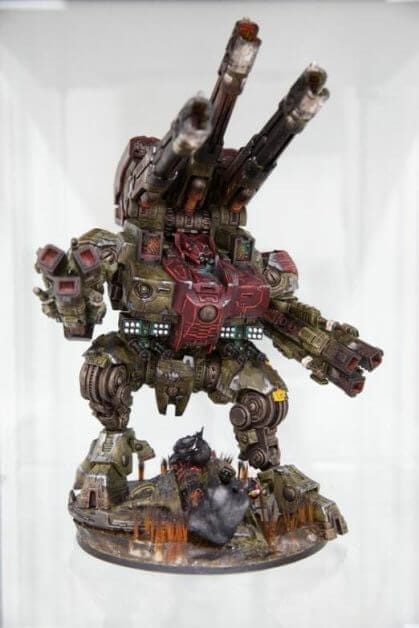
To paint Grimdark Tau, imagine a movie where the hero never catches a break and the rescued victims always get shot in the back at the last minute (sounds like a Korean zombie drama to me, actually, no spoilers). A Tau model will have endured countless battles and survived.
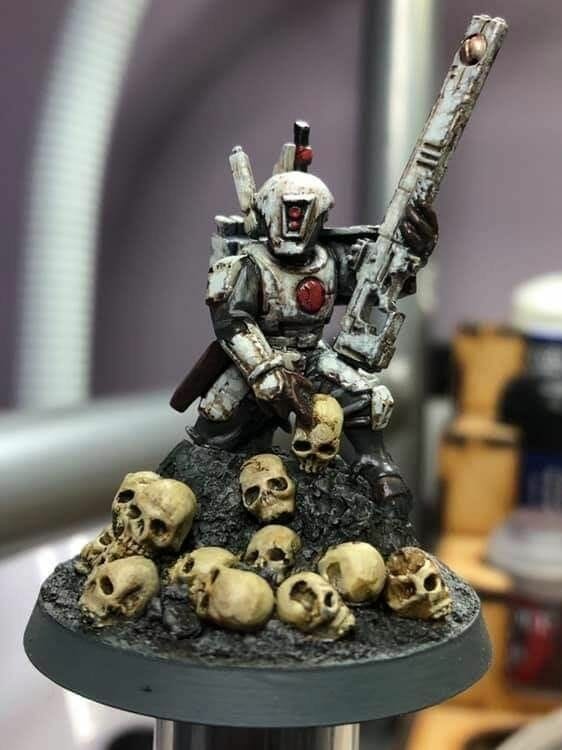
Your models can't be too shiny or "clean" (this doesn't mean sloppy). Instead, consider heavy weathering styles, chipping, and worn out machinery. Their surroundings should reflect this. Consider adding a bit of atmosphere to your model's bases, e.g., skulls, dirt, blood, and body parts.
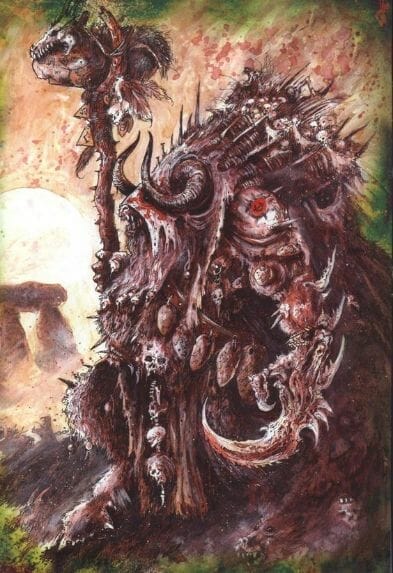
Use enamels or oil paints to achieve compelling and realistic appearing weathering effects and battle damage. Consider the John Blanche art style and use these Blanchitsu image references.
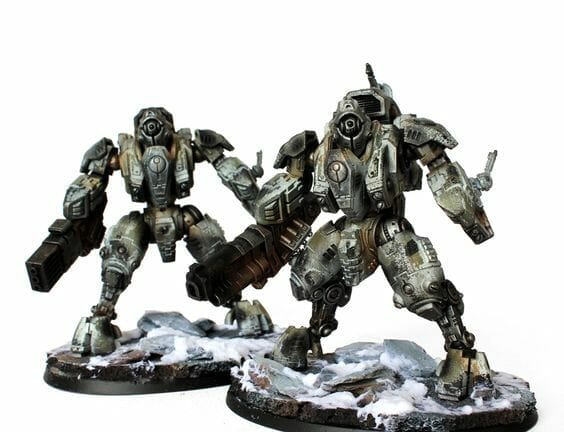
The Tau wield some of the most advanced weaponry in the 40k Universe. This doesn't mean it bodes well for them. Tau are often outnumbered, and rely on alien sub-race allies to help them in the fight, e.g., Kroot, Vespids. Use these other models to add some flair and organic grotesqueness in your Tau army collection.
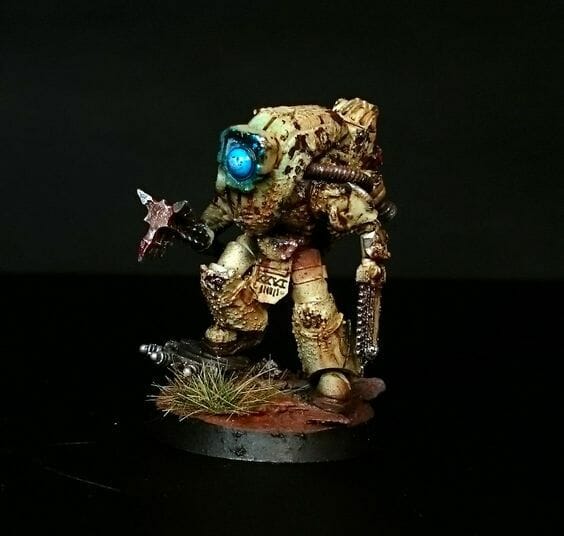
For a grimdark theme, remember to keep some brightness in your painting. You want contrast to make the dark that much deeper. "To light a candle, is to cast a shadow", wrote Ursula Le Guin. Can you achieve a sense of hope and take it all away in your painted miniature? To me, this is "grimdark". A hope that dies. Maybe a diorama would help.

Evoking a sense of true cynicism is the key to a successfully painted grimdark miniature, including Tau. Whatever you do for best effect, make something happy, and then back hand the smile. Knuckle out cheerfulness.
Here's a cool video tutorial for painting Grim dark Tau.
Conclusion
The T'au are one of the Warhammer 40k factions I'm highly looking forward to painting and finishing as part of my GW collection. I'm not exactly sure what my color motif will be. But, I've done a lot of research and collected my favorite image references.
Admittedly, I've painted Tau as part of painting commissions in the past and enjoyed the challenge of working with large surface areas, e.g., armor and panel lines, interspersed with fine mechanical details.
I hope you enjoyed this article and it has given you some ideas of what you could do with your Tau army. Perhaps, you could take some of these ideas and apply them to your other tabletop miniatures.
If you're looking for other Tau color scheme ideas, you can visit my Pinterest Page, or check out my post on ways to choose an army color scheme.
Happy Painting!
Enjoying your visit? Join Tangible Day
Free newsletter with monthly updates (no spam)
Leave a comment below! Follow on Twitter, Instagram, and Facebook.

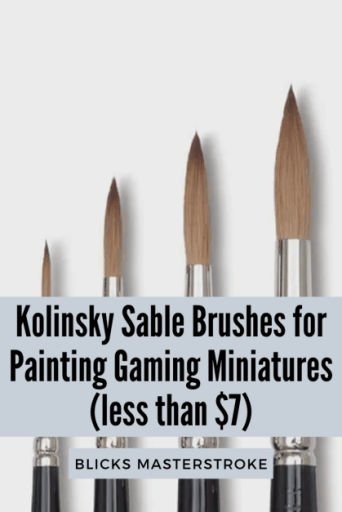
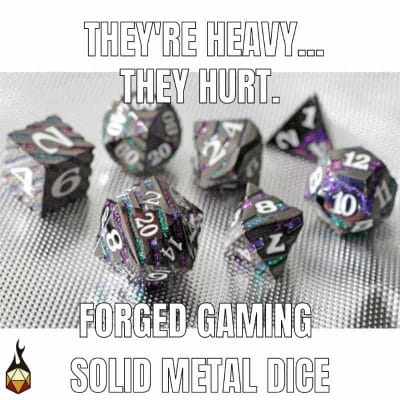

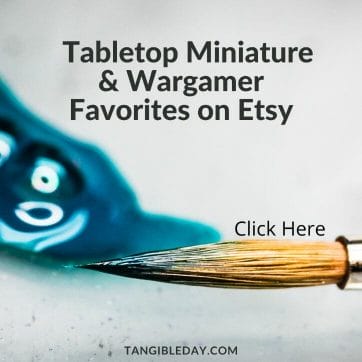
Source: https://tangibleday.com/tau-paint-schemes-9-color-motifs-and-ideas/
Postar um comentário for "Star Wars Paintings Using Cool Colors Easy Paintings Using Cool Colors"